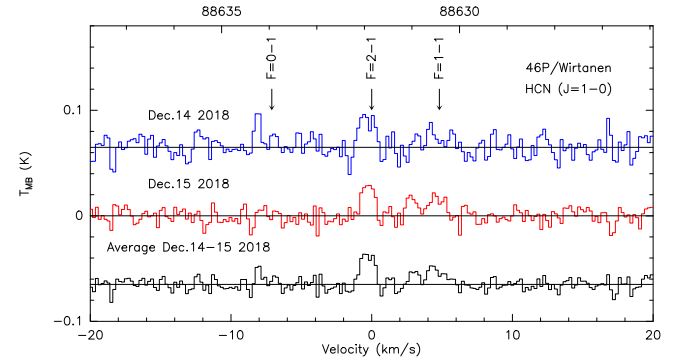Containing abundant oldest relics of solar nebula cloud, the comet 46P/Wirtanen in the Jupiter family with an orbital period of 5.5 years was discovered on 1948 January 15.Under the effect of solar ultraviolet radiation, kinematic property of the energy transfer and photochemical processes, the surface frozen substances of the comet are evaporated into gaseous species. The above processes cause the energy to increase, produces heat and inflation of neutral gas, which cause the brightness of the comet to reach8.8 m. On14-15December 2018, we completed a 16-hour observation on this comet with velocity resolution of 0.21km/s. We detected 88631.8473 MHz emission lines, and the associated flux density, expansion velocity and gas production rate. The observational data has provided an important basis for studying the oldest relics in the solar system and is significant for understanding the solar system and planetary origin and evolution.

By with ZHANG Shaobo Fig.1 Daily HCN(1–0) spectra observed toward 46P/Wirtanen on 2018 December 14–15. The satellite line of HCN(1–0) F = 1–1 and the main line F = 2–1 hyperfine components were detected on December 14 (blue line, top) and December 15 (red line, middle). The bottom spectrum (black line) was the two-day average. The vertical axis was the main beam brightness temperature TMB. The horizontal axis was the velocity scale with respect to the cometary rest velocity for the F = 2–1 main hyperfine component. The total integration time was about 6.6 hr, with the frequency resolution of 61.04 kHz, and velocity resolution of 0.21 km s?1 . We listed the fitting results in Table 2. The spectra of the HCN transitions with respect to the cometary nucleus, vHCN, was negative for matter moving closer to the observer. The line centers of the HCN spectral lines, with their line centers corresponding to the rest velocity of the cometary nucleus, were shown as a blueshift effect, assuming a rest central frequency of 88631.8473 MHz. Arecent new research achievement on detection of the 88631.8473 MHz emission molecule spectral lines in the volatilized gas of Comet 46P/ Wirtanen using the13.7m radio telescope of the Purple Mountain Observatory was published in The Astronomical Journal (2020, AJ, 159,240)by astronomers from the Xinjiang Astronomical Observatory, and Purple Mountain Observatory and others scientific research institutions. Article Link:https://iopscience.iop.org/article/10.3847/1538-3881/ab8734 |
